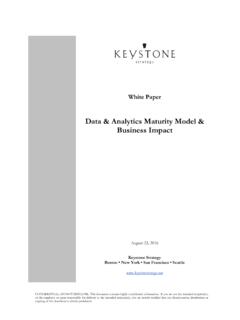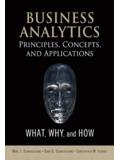Transcription of Healthcare Data Analytics - OHSU
1 3 Healthcare Data Analytics WILLIAM R. HERSH Learning Objectives After reading this chapter the reader should be able to: Discuss the difference between descriptive, predictive and prescriptive Analytics Outline the characteristics of Big Data Enumerate the necessary skills for a worker in the data Analytics field List several limitations of Healthcare data Analytics Discuss the critical role electronic health records play in Healthcare data Analytics Introduction ne of the promises of the growing critical mass of clinical data accumulating in electronic health record (EHR) systems is secondary use (or re-use) of the data for other purposes, such as quality improvement and clinical The growth of such data has increased dramatically in recent years due to incentives for EHR adoption in the US funded by the Health Information Technology for Economic and Clinical Health (HITECH) In the meantime, there has also seen substantial growth in other kinds of health-related data, most notably through efforts to sequence genomes and other biological structures and The analysis of this data is usually called Analytics (or data Analytics ).
2 This chapter will define the terminology of this field, provide an overview of its promise, describe what work has been accomplished, and list the challenges and opportunities going forward. Terminology of Analytics The terminology surrounding the use of large and varied types of data in Healthcare is evolving, but the term Analytics is achieving wide use both in and out of Healthcare . A long-time leader in the field defines Analytics as the extensive use of data, statistical and quantitative analysis, explanatory and predictive models, and fact-based management to drive decisions and actions .5 IBM defines Analytics as the systematic use of data and related business insights developed through applied analytical disciplines ( statistical, contextual, quantitative, predictive, cognitive, other [including emerging] models) to drive fact-based decision making for planning, management, measurement and learning.
3 Analytics may be descriptive, predictive or prescriptive. 6 Adams and Klein have authored a primer on Analytics in Healthcare that defined different levels and their attributes of the application of They noted three levels of Analytics , each with increasing functionality and value: Descriptive standard types of reporting that describe current situations and problems Predictive simulation and modeling techniques that identify trends and portend outcomes of actions taken Prescriptive optimizing clinical, financial, and other outcomes O From: Hoyt, RE, Yoshihashi, A, Eds. (2014). Health Informatics: Practical Guide for Healthcare and Information Technology Professionals, Sixth Edition. Pensacola, FL, Much work is focusing now on predictive Analytics , especially in clinical settings attempting to optimize health and financial outcomes.
4 There are a number of terms related to data Analytics . A core methodology in data Analytics is machine learning, which is the area of computer science that aims to build systems and algorithms that learn from One of the major techniques of machine learning is data mining, which is defined as the processing and modeling of large amounts of data to discover previously unknown patterns or A subarea of data mining is text mining, which applies data mining techniques to mostly unstructured textual Another close but more recent term in the vernacular is big data, which describes large and ever-increasing volumes of data that adhere to the following attributes:11 Volume ever-increasing amounts Velocity quickly generated Variety many different types Veracity from trustable sources With the digitization of clinical data, hospitals and other Healthcare organizations are generating an ever-increasing amount of data.
5 In all Healthcare organizations, clinical data takes a variety of forms, from structured ( , images, lab results, etc.) to unstructured ( , textual notes including clinical narratives, reports, and other types of documents). For example, it is estimated by Kaiser-Permanente that its current data store for its 9+ million members exceeds 30 petabytes of Other organizations are planning for a data-intensive future. Another example is the American Society for Clinical Oncology (ASCO) that is developing its Cancer Learning Intelligence Network for Quality (CancerLinQ).13 CancerLinQ will provide a comprehensive system for clinicians and researchers consisting of EHR data collection, application of clinical decision support, data mining and visualization, and quality feedback.
6 Another source of large amounts of data is the world s growing base of scientific literature and its underlying data that is increasingly published in journals and other articles (see Chapter on online medical resources). One approach to this problem that has generated attention is the IBM Watson project, which started as a generic question-answering system that was made famous by winning at the TV game show Jeopardy!14 IBM has since focused Watson in the Healthcare Kumar et al. have noted that the process of big data Analytics resembles a pipeline, and have developed an approach that specifies four major steps in this pipeline, to which we can place data sources and actions on it pertinent to Healthcare and The pipeline begins with input data sources, which in Healthcare and biomedicine may include clinical records, financial records, genomics and related data, and other types, even those from outside the Healthcare setting ( , census data).
7 The next step is feature extraction, where various computational techniques are used to organize and extract elements of the data, such as linking records across sources, using natural language processing (NLP) to extract and normalize concepts, and matching of other patterns. This is followed by statistical processing, where machine learning and related statistical inference techniques are used to make conclusions from the data. The final step is the output of predictions, often with probabilistic measures of confidence in the results. (figure ) The growing quantity of data requires that its users have a good understanding of its provenance, which is where the data originated and how trustworthy it is for large-scale processing and A number of researchers and thought leaders have started to specify the path that will be required for big data to be applied in Healthcare and An edited volume was recently published about Analytics applied in various aspects Healthcare and life A more peripheral but related term is business intelligence, which in Healthcare refers to the processes and technologies used to obtain timely, valuable insights into business and clinical data.
8 7 Another relevant term is the notion promoted by the Institute of Medicine of the learning health Advocates of this approach note that routinely collected data can be used for continuous learning to allow the Healthcare system to better carry out disease surveillance and response, targeting of Healthcare services, improving decision-making, managing misinformation, reducing harm, avoiding costly errors, and advancing clinical Figure The Analytics Pipeline (Adapted from Kumar)16 Another set of related terms come from the call for new and much more data-intensive approaches to diagnosis and treatment of disease variably called personalized medicine,25 precision medicine,26 or computational Advocates for these approaches note the inherent complexity of nonlinear systems in biomedicine, with large amounts and varied types of data that will need models to enable their predictive value.
9 Technology thought leader O Reilly notes that data science is transforming medicine, striving to solve its equivalent of the Wanamaker Dilemma for advertisers, named after the problem of knowing that half of advertising by merchants does not work, but that the half that does not work is not One of the major motivators for data Analytics comes from new models of Healthcare delivery, such as accountable care organizations (ACOs), where reimbursement for conditions and episodes is bundled in a variety of ways, providing incentive move to deliver high-quality care in cost-efficient ACOs require a focused IT infrastructure that provides data that can be used to predict and quickly act on excess One of the challenges for Healthcare data is that patients often get their care and testing in different settings ( , a patient seen in a physician office, sent to a free-standing laboratory or radiology center, and also seen in the offices of specialists or being hospitalized.)
10 This has increased the need for development of health information exchange (HIE), where data is shared among entities caring for a patient across business A well-known informatics blogger has succinctly noted that ACO = HIE + Analytics .32 Challenges to Data Analytics There are, of course, challenges to data Analytics . One concern is that data generated in the routine care of patients may be limited in its use for analytical For example, such data may be inaccurate or incomplete. It may be transformed in ways that undermine its meaning ( , coding for billing priorities). It may exhibit the well-known statistical phenomenon of censoring, , the first instance of disease in record may not be when it was first manifested (left censoring) or the data source may not cover a sufficiently long time interval (right censoring).


